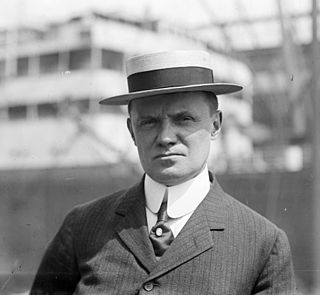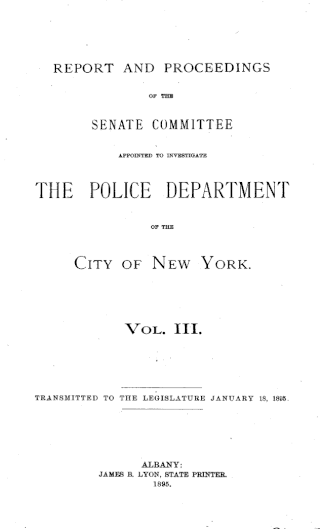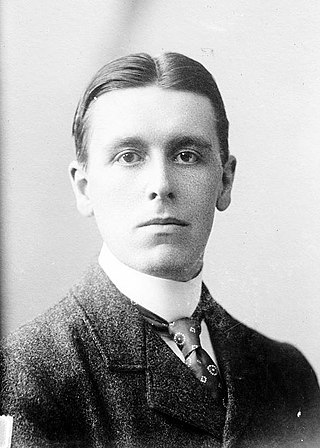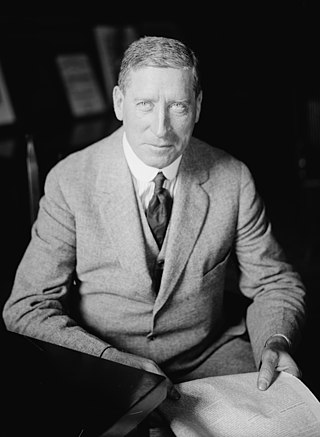Related Research Articles

James John Walker, known colloquially as Beau James, was mayor of New York City from 1926 to 1932. A flamboyant politician, he was a liberal Democrat and part of the powerful Tammany Hall machine. He was forced to resign during a corruption scandal.

Tammany Hall, also known as the Society of St. Tammany, the Sons of St. Tammany, or the Columbian Order, was a New York City political organization founded in 1786 and incorporated on May 12, 1789 as the Tammany Society. It became the main local political machine of the Democratic Party, and played a major role in controlling New York City and New York State politics and helping immigrants, most notably the Irish, rise in American politics from the 1790s to the 1960s. It typically controlled Democratic Party nominations and political patronage in Manhattan after the mayoral victory of Fernando Wood in 1854, and used its patronage resources to build a loyal, well-rewarded core of district and precinct leaders; after 1850 the vast majority were Irish Catholics due to mass immigration from Ireland during and after the Irish Famine.

In the politics of representative democracies, a political machine is a party organization that recruits its members by the use of tangible incentives and that is characterized by a high degree of leadership control over member activity. The machine's power is based on the ability of the boss or group to get out the vote for their candidates on election day.

Charles Seymour Whitman was an American lawyer who served as the 41st Governor of New York from January 1, 1915, to December 31, 1918. An attorney and politician, he also served as a delegate from New York to the 1916 Republican National Convention. He had previously served as deputy and New York County District Attorney, in addition to state judge.

Carmine Gerard DeSapio was an American politician from New York City. He was the last head of the Tammany Hall political machine to dominate municipal politics.
Albert Jacob Cardozo was an attorney and an American jurist in New York.

Lexow Committee was a major New York State Senate probe into police corruption in New York City. The Lexow Committee inquiry, which took its name from the committee's chairman, State Senator Clarence Lexow, was the widest-ranging of several such commissions empaneled during the 19th century. The testimony collected during its hearings ran to over 10,000 pages and the resultant scandal played a major part in the defeat of Tammany Hall in the elections of 1894 and the election of the reform administration of Mayor William L. Strong. The investigations were initiated by pressure from Charles Henry Parkhurst.

Charles Henry Parkhurst was an American clergyman and social reformer, born in Framingham, Massachusetts. Although scholarly and reserved, he preached two sermons in 1892 in which he attacked the political corruption of New York City government. Backed by the evidence he collected, his statements led to both the exposure of Tammany Hall and to subsequent social and political reforms.

Franklin D. Roosevelt was elected governor of New York in 1928 and served from January 1, 1929 until his election as President of the United States in 1932. His term as governor provided him with a high-visibility position in which to prove himself as well as provide a major base from which to launch a bid for the presidency.

Robert Lawrence Moran, was a Bronx politician who served as president of the Board of Aldermen of New York City from 1918 to 1920, filling a vacancy after Alfred E. Smith was elected Governor of New York. Nominated by the Democratic Party to succeed himself as board president, Moran faced Republican Representative Fiorello H. La Guardia in the election of 1919, losing by a plurality of 1,363 votes. Moran has the distinction of being the only citizen of The Bronx to ever exercise the authority of mayor of New York City, even though this honor came to him only in his capacity as acting mayor during Mayor Hylan's absences from the city.

Samuel Seabury was an American lawyer and politician from New York. Seabury is famous for dedicating himself to a campaign against the corrupt Tammany dominance of New York City politics. He later presided over the extensive 1930–32 investigations of corruption in the New York City municipal government, which became known as the 'Seabury Hearings'. Seabury became a Georgist after reading Progress and Poverty.

Judge George Washington Olvany was a New York General Sessions Court judge, the deputy New York City Fire Commissioner, and the leader of Tammany Hall.

The New York City Bar Association was founded in 1870 as a voluntary professional organization for lawyers in New York City. It is the country's oldest bar association, and with over 24,000 members, continues to be one of its largest and most influential.

Charles Henry Tuttle was an American lawyer, politician and civic activist. He was the 1930 Republican nominee for Governor of New York in the election against Franklin D. Roosevelt.
The Committee of Seventy was a committee of 70 citizens of New York City, formed in 1871 and under the lead of Samuel J. Tilden, which conducted an investigation and prosecution of misuse of government office by William M. Tweed.
Samuel Harold Hofstadter was an American lawyer and politician from New York.
John J. McNaboe was an American lawyer and politician from New York.

Jean Hortense Norris was an American judge, the first woman magistrate in New York City. She was appointed to the bench in 1919, but disbarred in 1931, for judicial malfeasance.

The 1932 New York City special mayoral election was held on November 8. It was triggered by the resignation of incumbent Democratic Mayor Jimmy Walker on September 1, after his administration had become embroiled in scandal. Democratic nominee John P. O'Brien easily defeated Republican Lewis H. Pounds and Socialist Morris Hillquit. Acting Mayor Joseph V. McKee also featured as a write-in candidate. Minor candidates included Communist William L. Patterson and Socialist Labor candidate Olive Johnson.

The New York City mayoral election of 1933 took place on November 7, 1933 in New York City. Incumbent Democratic Mayor John P. O'Brien, who was elected in a special election after the resignation of Mayor Jimmy Walker, faced Republican Congressman and 1929 mayoral candidate Fiorello La Guardia, and former acting mayor and President of the New York City Board of Aldermen Joseph V. McKee, who became acting mayor after Walker's resignation until the special election, and ran on the Recovery Party line.
References
- ↑ Allen, Oliver E. (1993). The Tiger: The Rise and Fall of Tammany Hall. Addison-Wesley Publishing Company. p. 233-250. ISBN 0-201-62463-X.
- ↑ Shteir, Rachel (February 25, 2013). "The Dead Woman Who Brought Down the Mayor". www.smithsonianmag.com. Retrieved January 14, 2019.
- ↑ Allen p. 242
- 1 2 3 4 Allen, Oliver E. (1993). The Tiger: The Rise and Fall of Tammany Hall. Addison-Wesley Publishing Company. p. 243-246. ISBN 0-201-62463-X.
- ↑ "Samuel Seabury (1873-1958)". Historical Society of the New York Courts.
- ↑ New York State Supreme Court Appellate Division First Department, About the Court 1930-39, available at http://www.courts.state.ny.us/courts/ad1/centennial/1930_1939.shtml.
- ↑ "Bar Renews Fight on Judicial 'Deals'" (PDF). The New York Times. December 14, 1932.